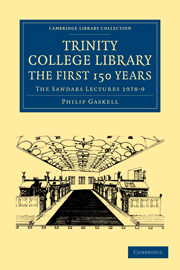Book contents
- Frontmatter
- Contents
- Lists of illustrations and plans
- Preface
- Terms and conventions
- Abbreviations
- 1546–1600
- 1601–1695
- 9 The New Library
- 10 Stanhope's Librarianship
- 11 Collections of manuscripts
- 12 The growth of the working collections, 1601–40
- 13 The arrangement of the books, 1601–40
- 14 Administration and reorganisation, 1641–74
- 15 The book stock, 1667–95
- 16 The last years of the New Library
- APPENDIXES
- Index
15 - The book stock, 1667–95
Published online by Cambridge University Press: 05 August 2011
- Frontmatter
- Contents
- Lists of illustrations and plans
- Preface
- Terms and conventions
- Abbreviations
- 1546–1600
- 1601–1695
- 9 The New Library
- 10 Stanhope's Librarianship
- 11 Collections of manuscripts
- 12 The growth of the working collections, 1601–40
- 13 The arrangement of the books, 1601–40
- 14 Administration and reorganisation, 1641–74
- 15 The book stock, 1667–95
- 16 The last years of the New Library
- APPENDIXES
- Index
Summary
The structure and development of the Library's book stock in the period 1667–95 can be followed in detail in the two indexed class catalogues of the later seventeenth century (1667 and 1675 in Appendix B). The earlier and more abbreviated of these catalogues was copied out by Thomas Griffith the Librarian in 1667, and was then added to until about 1675, when it was superseded by a more detailed class catalogue written by James Manfeild, Griffith's successor in the Librarianship. Manfeild's catalogue was added to in turn until 1695, when the whole collection was transferred to the Wren Library and the old class catalogues were replaced.
An analysis of the library books by classes shows both the general characteristics of the collection and the tendency of its development in the later seventeenth century. The following tables show that the Library still had a preponderance of divinity books during the third quarter of the century, but that the proportion of books on subjects other than divinity was steadily rising. It appears from the draft class catalogue of c. 1645 that there were then about 56 per cent of divinity books and 44 per cent of books on other subjects; but by 1667 there were only 52 per cent of divinity books to 48 per cent of others; while by 1695 the percentage of divinity books was down to 51, scarcely more than half the total book stock.
- Type
- Chapter
- Information
- Trinity College Library. The First 150 YearsThe Sandars Lectures 1978–9, pp. 126 - 133Publisher: Cambridge University PressPrint publication year: 2010First published in: 1980



